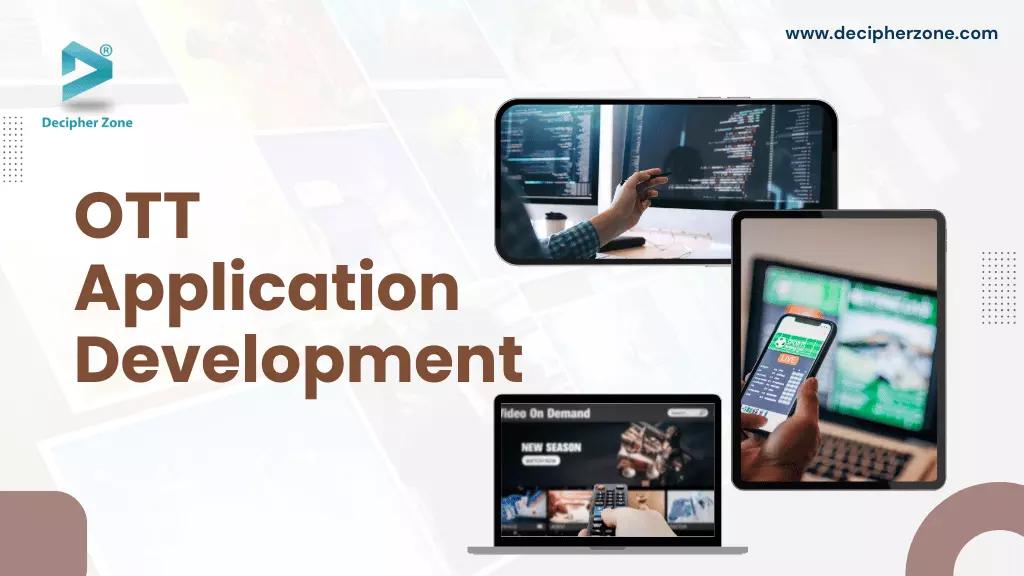You can discover all you need to know about OTT platform development before building yours. This blog covers what OTT application development is, what are the types, what are the features, the development process, monetization strategies, challenges faced, tips to improve, and the cost of developing one.
Do you feel nostalgic thinking there was a time when we used to plan our evenings around a TV show to catch the latest episode or a movie streaming? But we no longer have to rearrange our schedules or remember showtimes.
Instead, Over-the-Top (OTT) platforms have revolutionized the way we consume content. Now, we have the power to watch our favorite shows, movies, and even live events anytime, anywhere, and in countless languages with just a few clicks.
It’s more like the convenience of having personal cinema right in our pockets, OTT platforms are designed to deliver a seamless viewing experience that transcends geographical boundaries, allowing you to commute anywhere, the world of entertainment is literally at your fingertips.
Looking at our society nowadays OTT platforms are more like a necessity than a luxury, where people expect instant access to content, personalized recommendations, and high-quality streaming services.
OTT Application Development Cost, Features and Benefits
In This Article, You’ll Explore:
-
What are OTT app development, current demands, and the importance of the OTT platform,
-
Why you should invest in OTT platforms,
-
How many types of OTT platforms you can develop,
-
What are the core features of OTT apps that can help you develop a successful solution,
-
What is the process of developing an OTT platform in detail,
-
How you can make your OTT app a source of income, and what strategies to implement,
-
What are the challenges you will face while an OTT app development and its solutions,
-
What are the tips or best practices for developing an OTT application,
-
What is the cost of developing an OTT app,
What is OTT (Over-the-Top) App Development?
OTT App Development is creating a mobile or web-based platform on which high-quality content is delivered over the Internet to users' devices, making them more accessible than traditional cable TV, or broadcast services. OTT apps let you stream what you want and when you want. You can think of OTT apps as your ticket to entertainment without the middlemen.
It is kind of a feast on your favorite content at your own pace. Whether you are craving a late-night movie marathon, a quick episode during lunch, or live sports on the go, it’s all just a click away.
But here is the kicker–Building an OTT app isn’t a walk in the park. It takes a long run process involving design, coding, testing, and managing the project from scratch to finish. Think of it as you are assembling a team of superheroes like the Avengers, each with their own powers to bring you that Bing-worthy seamless experience.
Why Should You Invest in an OTT App Development?
OTT platforms are set for continued expansion and innovation, looking ahead to 2025, predictions indicate that the penetration rate of OTT services will rise to 49.77%, demonstrating a robust shift toward digital media consumption.
OTT works as your passport offering your businesses access to a global audience like never before. With just a few taps, content can be streamed on any device that has an Internet connection. It can be a smartphone in Tokyo, a smart TV in London, or a Tablet in New York, leading businesses to cast their net wide, fishing for viewers from diverse backgrounds, cultures, and personal preferences.
Businesses can also cater to niche markets that traditional broadcasting often overlooks, opening a treasure trove of opportunities to boost engagement, connecting with audiences around the globe, building brand loyalty, and ultimately, generating a source of revenue.
What Types of OTT Platforms You Can Develop?
If you believe that OTT app development is a one-way street to creating another Netflix, it’s time to hit the brakes! OTT app development is a vibrant universe filled with various types of apps, each catering to a unique user base. For this, you need some solid research to know what your target audience craves.
Let’s see what else is on the table, and get to know if OTT app development is not just streaming videos than what..?
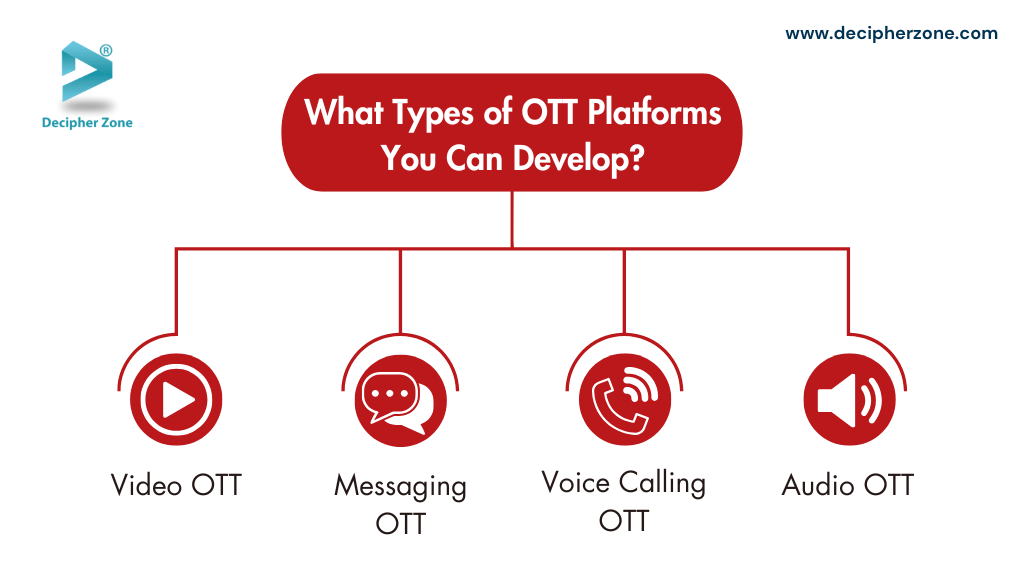
1. Video OTT
The best example of Video OTT is your go-to spot for binge-watching the latest series or rewatching classic films on Netflix, Sling TV, Hulu, etc. There are platforms that serve up on-demand videos, TV shows, movies, and original content. These are the heavyweights of the streaming world.
2. Messaging OTT
Applications like WhatsApp, Facebook Messenger, WeChat, and Telegram are the social butterflies of the OTT scene that allow instant communication, letting you have endless conversations, share memes, and stay connected with friends and family. These groups chat you never knew you needed, bringing people closer.
3. Voice Calling OTT
Ever felt lonely and wanted your friend who is in a different city/ country near you? Voice Calling OTT platforms like Skype, FaceTime, and Zoom, are here to save your day! With VoIP (Voice over Internet Protocol), you can chat away without worrying about those hefty long-distance and long bills. You can connect to anyone no matter where you are in the world with an internet connection.
4. Audio OTT
Audio OTT apps like Spotify, Apple Music, and Amazon Music are your personal jukeboxes that allow you to stream your favorite music on repeat or shuffle. These platforms provide the perfect playlists for every occasion, for every mood, whether you’re in the gym, at home, or throwing a party with just a click you can have the world of music in your pocket.
Core Features of a Successful OTT App
Do you know what sets a great OTT platform apart from the ordinary? A flawlessly smooth, user-centric experience that keeps viewers coming back, driven by the platform's essential features. Here is the list of features to consider for your user-centric audience,
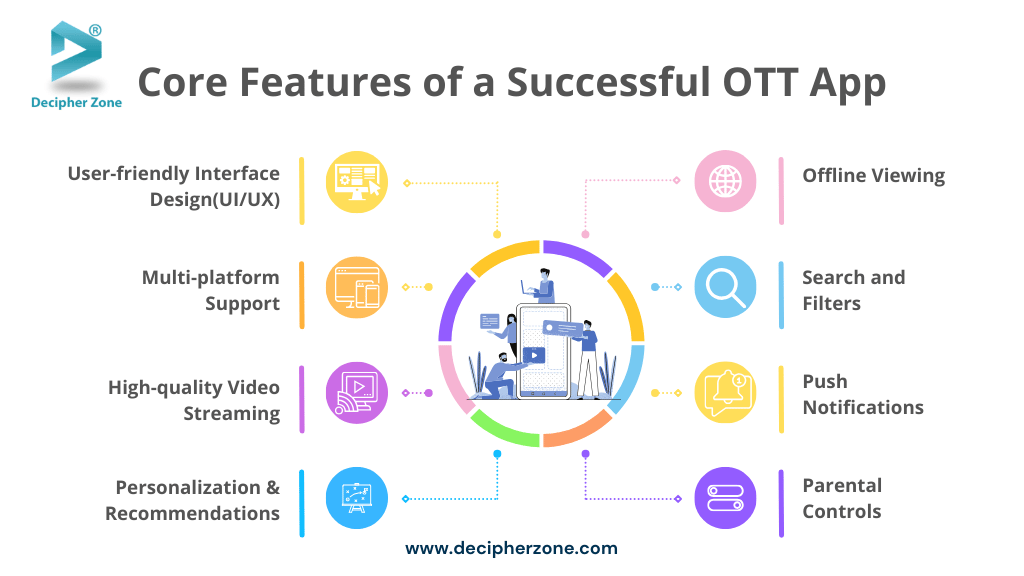
1. User-friendly Interface Design(UI/UX)
A user-friendly interface should be as organized as a well-kept library, making it easy for readers to find books. Similarly, an intuitive app enables users to navigate quickly and locate the content they want. This is the cornerstone of any successful OTT app. For example, if a user wants to watch a movie with a hot pizza waiting on the table but can't find the one they want to watch, it can be frustrating. To prevent such situations, easy navigation for users is essential to help them dive straight into content effortlessly.
2. Multi-platform Support
Picture this: You start watching a show on your phone during your commute, then effortlessly switch to your smart TV at home. To achieve this, applications need to make sure to have various compatible devices.
The multi-platform functionality has become the basic requirement for users, as they expect to access their favorite content on any Internet-connected device. The seamless streaming on smart TVs, laptops, tablets, and gaming devices isn’t just convenience anymore: it’s essential for keeping viewers engaged.
3. High-quality Video Streaming
High-quality video streaming can be your secret weapon. Nobody likes buffering, your app needs to ensure adaptive bitrate streaming that adjusts the video quality based on the user’s Internet speed. Those with high-speed connections get the best visual experience possible, while those with slower connections can still stream without interruption.
4. Personalization & Recommendations
AI and machine learning help increase engagement and watch time by personalized recommendations to the users. Think about Netflix’s recommendations engines seem to know exactly what you’re in the mood for. This personalization and recommendations are crucial to keeping users hooked and are key to user retention.
5. Offline Viewing
Offline viewing is a must-have feature that allows you to have access to the content even without an internet connection. Whether the user is on a long flight or in an area with poor internet connectivity, this feature ensures that users can enjoy uninterrupted entertainment. Popular applications like Spotify, YouTube Premium, and Disney+ offer offline downloads which sets the standards and lets users use them even when they are traveling.
6. Search and Filters
Sometimes users want some specific content instead of scrolling endlessly, with the search bar and advanced filters like genre, language, release date, and more helping them quickly find what they’re looking for. Some of the applications like Amazon Prime Video excel at offering these easy-to-use filters and advanced search functions.
7. Push Notifications
This can be a powerful tool when used strategically, whether it’s notifying them about the new show based on their preferences, upcoming releases, or personalized offers. Push notifications can boost user engagement without being intrusive. These notifications can nudge users to continue watching a series or check out new arrivals.
8. Parental Controls
The families with young viewers, parental controls are a must, allowing parents to restrict access to certain content. This ensures age-appropriate viewing experiences with users to set profiles with content filters, PIN protection, and viewing restrictions based on ratings. This not only ensures user trust but also creates a safe family-friendly environment on your platform. Apps like Netflix and Disney+ provide robust parental controls allowing parents to restrict content with various alternatives.
6 Steps of OTT App Development Process
OTT App Development is like crafting a masterpiece, it’s intricate, and challenging, but rewarding once you get it done with a super smooth solution. Every step requires precision, creativity, and a deep understanding of what your audience really wants just like assembling all the perfect pieces to deliver seamless streaming experiences.
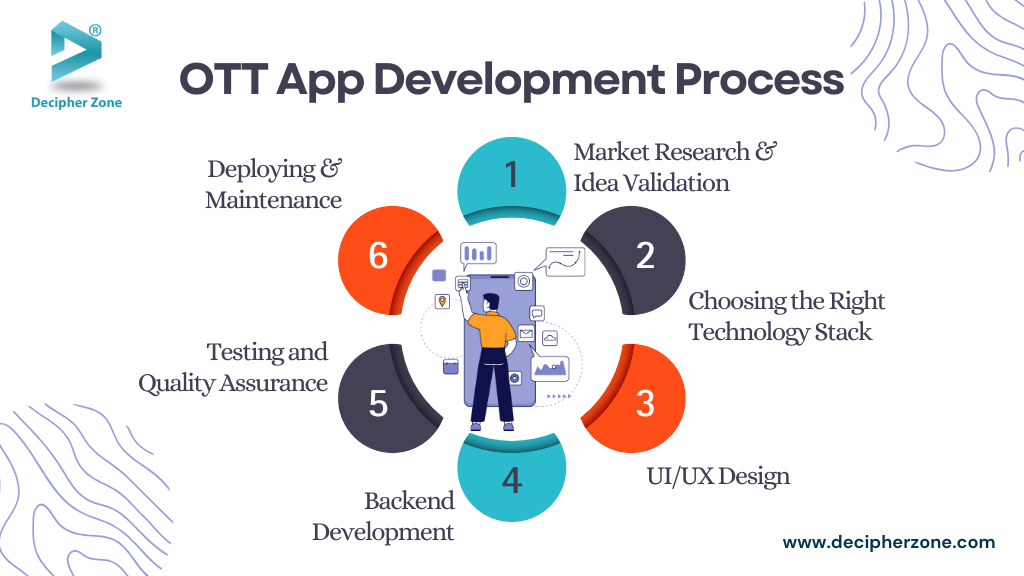
Step 1: Market Research & Idea Validation
It is important to conduct market research before jumping into development. This step involves analyzing competitors, understanding your target audience, and identifying gaps in the market. Study the pain points with the following questions,
-
Who is your target audience and what value will your app provide them?
-
Do they already spend money on similar platforms, or if so then how can you improve their experience with yours?
-
What features and functionality does your OTT app have that differ from the competitors?
-
What do users expect from an OTT application or how do you evaluate it?
-
How will the needs of the users differ depending on what they are watching and what they want to watch?
Step 2: Choosing the Right Technology Stack
Choosing the right tech stack for your OTT application is like the foundation of a building– it’s what holds everything up and ensures stability as your app grows and serves more users, handles spikes in traffic, and provides a seamless experience.
There is a list of frameworks and technologies you can choose from depending on your requirements, features, and functionalities. For mobile app development, React Native, Flutter, and Swift are flexible to support both iOS and Android platforms. For web development, Angular and Node.js are the walls and pillars of your structure.
Finally, for the infrastructure and scalability to keep your app performing well under heavy traffic, popular cloud solutions like AWS, Google Cloud, and Mircosoft Azure are widely used.
Interested in learning more about Choosing The Best Technology Stack For Web App Development? This blog can provide you the insightful information.
Step 3: UI/UX Design
Just like a welcoming entrance draws people in, an intuitive and visually appealing UI/ UX design can make users feel instantly at home, encouraging them to explore and engage.
No need to dig through endless resources or go on a treasure hunt for answers to UI/ UX design—just click the link, and you’ll be instantly transported to a detailed guide on How to Hire a UI/UX Designer and Developer. It’s like having a shortcut to the perfect roadmap, saving you time and giving you everything you need in one place!
Step 4: Backend Development
The backend works like an engine that powers your Ott app and handles everything from video storage and content management to user authentication and payment systems. A seamless OTT platform is considered successful when it runs smoothly even during peak traffic. The integration of content Delivery Networks (CDNs) ensures fast, global delivery of video content by caching it on local servers, reducing latency and buffering issues.
Step 5: Testing and Quality Assurance
The continuous testing process and quality assurance make sure the application works smoothly as developers identify and resolve bugs throughout the process. The testing process is a success if the answer to the following questions is yes,
-
Does every functionality or feature work?
-
Can the platform handle high traffic?
-
Is the OTT application compatible across all the devices?
Step 6: Deploying & Maintenance
Once the testing is done, it’s time to deploy it to the right platform–Whether it’s Google Play, the App Store, or as a web application. Think of this as choosing the best highway for your app to reach its users. Either you can go for a soft launch, like taking the app for a quiet test drive to gather user feedback or go all out with a full-scale marketing blitz with everything you’ve got.
Even after the launch, the process doesn't end here. Regular updates are your pit stops, to identifying bugs, rolling out new features, and ensuring your application continues to run smoothly and keeps users coming back for more.
Top 4 Monetization Strategies for OTT Apps
Monetizing your OTT application is not just about making some extra cash, if strategize appropriately, your business can elevate in more ways than possible. By implementing the right monetization model, you can boost revenue and also create a sustainable growth plan. Here is a list to see which one fits your platform best:
1. Subscription Model (SVOD)
SVOD is like a VIP club, the users can pay a monthly or annual fee to access unlimited content. Platforms like Netflix, Hulu, and Disney+ thrive on this model by offering various subscription tiers based on features like ad-free viewing and multi-device streaming. The beauty of SVOD is that the users can choose the level of service that fits their budget while keeping the content pipeline flowing.
2. Ad-Supported Model (AVOD)
AVOD is a no-entry-fee with a few ads as these platforms generate revenue through advertising. This model is for users who prefer free content but don’t mind an occasional ad break, these ads are beneficial for advertisers by offering targeted ads based on user preferences, giving them a source of income.
Pro Tip: AVOD can work as an introduction to your platform, converting free users into paying subscribers later on.
3. Transactional Model (TVOD)
TVOD also known as Pay-per-view allows users to pay a one-time fee to watch a piece of content, for example paying to watch a specific show, event, or broadcast. TVOD works like a digital vending machine, users pay for individual content like movie rentals or purchases. Plus, with a rent-and-buy option to allow the users to have access to blockbusters or exclusive content like new releases.
4. Freemium Model
This model allows users to have access to limited content and the user can upgrade to premium to access enhanced features like ad-free content, offline viewing, or higher-quality streaming. Platforms like Spotify and Crunchyroll build a large user base and nudge free users into upgrading to premium tiers over time. This is especially effective for niche audiences or specialized content, where users see the value in upgrading to unlock premium experiences.
4 Common Challenges in OTT App Development
Developing an OTT application comes with a set of challenges similar to the challenges faced while setting up a massive outdoor concert, you have to double-check for sound cuts out, the stage lights flickers– anything can quickly turn into chaos. Identifying the challenges can either break or make your user experience, ensuring top-notch streaming quality to protecting user data, every piece needs to work in harmony.
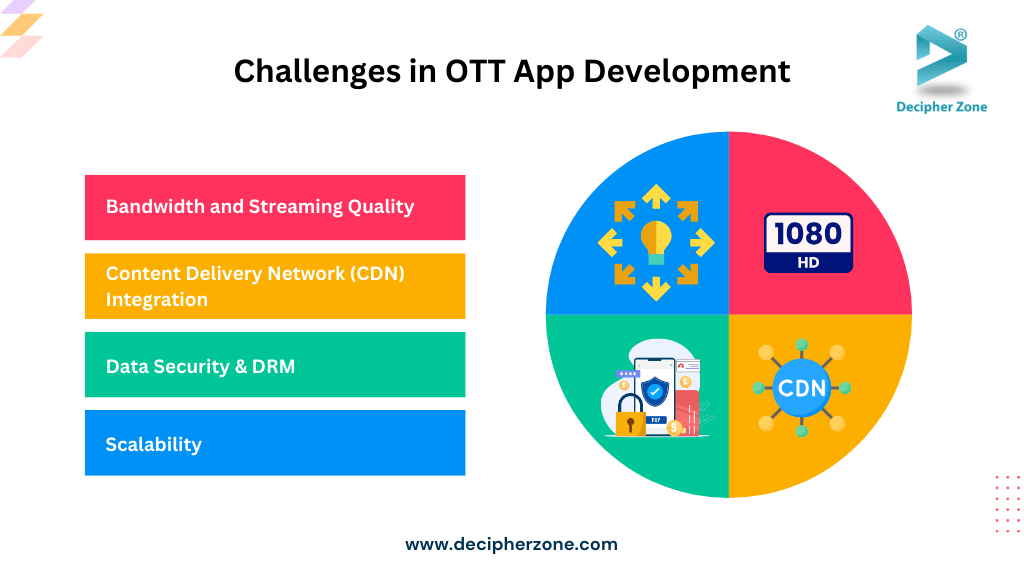
1. Bandwidth and Streaming Quality
Imagine while streaming the latest blockbuster and it starts to buffer. Isn’t it frustrating? Bandwidth and streaming quality are all about delivering high-definition content with minimal lag. Using adaptive bitrate technology which adjusts the video quality depending on your internet speed, ensuring low latency so your users don’t feel like they are stuck in a slow-motion scene.
2. Content Delivery Network (CDN) Integration
Content delivery network (CDN) is the global delivery driver for your app. For example, if someone in Tokyo wants to stream your content, you don’t want them waiting on a server in New York to send the data. CDNs make sure your content is stored in multiple locations worldwide, reducing delays and improving the streaming speed.
3. Data Security & DRM
Data breaches are as scary as villains in horror movies. Ensuring data security is non-negotiable as OTT apps deal with a treasure trove of user data like payment details, preferences, and personal information. Digital Rights Management (DRM) is the bodyguard that protects your content, preventing unauthorized sharing or downloads.
4. Scalability
Your app needs to grow alongside your audience without crashing or slowing down. At the time of any live event, millions of people could be streaming. Building with cloud infrastructure like AWS or Google Cloud allows your app to handle traffic spikes effortlessly.
Tips to Develop a Successful OTT App
The seamless experience of streaming doesn’t happen by accident– it requires strategy, creativity, and a user-first mindset. Below is the list of essential tips to ensure your OTT app becomes the go-to spot for binge-watchers, gamers, music lovers, or anyone in between.
-
Collaboration with industry experts can provide valuable insightful feedback about what works or what not
-
Keeping an eye on the latest industry trends and updates to stay up-to-date and stay ahead of the competition.
-
Addressing compatibility issues across various devices and operating systems to reach larger audiences.
-
Building a loyal customer base by releasing regular updates that improve your app’s functionality and help keep users engaged and satisfied.
-
By adding a multilingual feature, your app can offer subtitles, dubbing, and even localized content to the users to cater to a vast area of users of different cultural and linguistic markets.
-
Your app can help build a community around your content, fostering social interaction and boosting engagement through features like live chats, user reviews, and sharing recommendations.

Cost of Developing an OTT Application
Developing an OTT application is much like building your dream house. Sure, you’ll want the best features, from sleek interfaces to robust streaming capabilities but don’t forget to check the price tag! For that you need the right development partner like a co-pilot for a long flight– you need someone who knows how to navigate challenges and can guide you through within your budget considering all the factors.
On average building an OTT platform can range from $30,000 to $300,000 or more depending on the factors including platform choice (web, mobile or multiplatform), features and functionality, UI/UX design, licensing and legal fees, and testing and maintenance.
Final Thoughts
Pick the top chef (right development team) to bring your dream menu (OTT app) to life. With Decipher Zone, you are in trusted hands! Our developers know the perfect recipe for success- balancing all the ingredients like features, design, and performance while sticking to your budget, ensuring your OTT app sets to dazzle and meet your users' requirements right from the initial launch!
 (1).png)
FAQs
1. What makes a good OTT app platform?
An ideal OTT application is a seamless solution that offers high-quality content on which users can rely for a streaming experience along with a large library of fresh and premium content. The UI/ UX design should be easy to navigate for the users, with minimal buffering, and high-resolution playback. To compete in the market, the application should also integrate or implement trending technologies.
2. Is investing in OTT app development a smart move?
OTT platforms are set for continued expansion and innovation, looking ahead to 2025, predictions indicate that the penetration rate of OTT services will rise to 49.77%, demonstrating a robust shift toward digital media consumption. Businesses can also cater to niche markets that traditional broadcasting often overlooks, opening a treasure trove of opportunities to boost engagement, connecting with audiences around the globe, building brand loyalty, and ultimately, generating a source of revenue.
3. How much time does an OTT application need to develop?
The time it takes to develop an OTT (Over-The-Top) app varies based on the intricacy of the platforms, available resources, and the range of features to be included. Generally, it can take around 8 to 12 months or even longer to complete the development and have the platform ready for deployment.
4. How does an OTT app generate revenue?
With the various monetization models like the Subscription Model (SVOD), Ad-Supported Model (AVOD), Transactional Model (TVOD), and Freemium Model businesses can generate revenue from the OTT apps.

